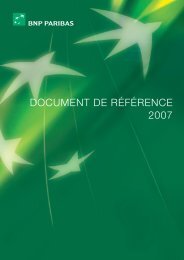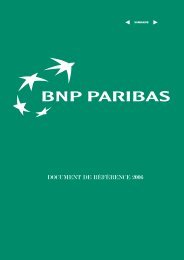2007 REGISTRATION DOCUMENT
2007 REGISTRATION DOCUMENT
2007 REGISTRATION DOCUMENT
- No tags were found...
You also want an ePaper? Increase the reach of your titles
YUMPU automatically turns print PDFs into web optimized ePapers that Google loves.
5 NotesCONSOLIDATED FINANCIAL STATEMENTSto the financial s tatements p repared in accordance with I nternational Financial Reporting S tandards as adopted by the European UnionTransactions initiated by the Bank in France are transferred to ALMmanagedpositions via internal contracts booked in the managementaccounts. Interest rate and liquidity positions on commercial transactionsinitiated by Group subsidiaries (other than BancWest) are transferred inthe form of loans and borrowings based on the entity’s net position.Positions are measured and transfers to ALM-Treasury are controlled atmonthly or quarterly committee meetings for each business line. Thesemeetings are attended by the management of the business line, ALM-Treasury, and the business line ALM managers (who have a dotted-linereporting relationship with ALM-Treasury).Interest rate risk on the commercial activities of the subsidiaries ofBancWest Corp. is independently managed by the Bank of the Westand First Hawaian Bank ALM units, which report to each subsidiary’sexecutive management via monthly committee meetings.Measurement of interest rate riskBanking book interest rate gaps are measured, with embeddedbehavioural options translated into delta equivalents. Maturitiesof outstanding assets are determined based on the contractualcharacteristics of the transactions and historical customer behaviour.For retail banking products, behavioural models are based on historicaldata and econometric studies. The models deal with early repayments,regulated savings accounts and current accounts in credit and debit.Theoretical maturities of equity capital are determined according tointernal assumptions.In the case of retail banking activities, structural interest rate risk is alsomeasured on a going-concern basis, incorporating dynamic changesin balance sheet items. Due to the existence of partial or even zerocorrelations between customer interest rates and market rates, and thevolume sensitivity caused by behavioural options, rotation of balancesheet items generates a structural sensitivity of revenues to interestrate changes.Lastly, for products with underlying behavioural options, a specific optionrisk indicator is analysed in order to fine-tune hedging strategies.These indicators are systematically presented to specialist committees,and serve as the basis for hedging decisions taking into account thenature of the risk involved. In <strong>2007</strong>, teams with no reporting relationshipwith product control units were set up to oversee the production ofthese indicators. In addition, Group Risk Management continued tocontrol risks arising from the use of behavioural models by the ALMunit. The results of these controls are presented once a year to the Boardof Directors and periodically to the ALM committees.< Contents >Risk limitsThe euro customer banking intermediation book is subject to a primarylimit, based on the sensitivity of revenues to gradual changes in nominaland real interest rates and in the inflation rate over a five-year timeframe.The changes are defined by reference to historical volatility data andcorrelations between the various parameters. The limit is based on annualrevenues, in order to control uncertainty about future fluctuations inrevenues caused by changes in interest rates. This limit is supplementedbeyond the five-year timeframe by an interest rate gap limit, expressedas a percentage of customer deposits. This percentage is a decliningfunction of the management period. This limit is used to manage longterminterest rate risk.The exposure to interest rate risk of BancWest Corp. subsidiaries iscontrolled by means of limits on the sensitivity of annual revenues to animmediate change in nominal rates. Sensitivity is monitored at quarterlymeetings of the BancWest ALM committee.Global interest rate risk on the other intermediation books is controlledby interest rate gap limits, which are monitored monthly and adjustedannually by the ALM Commercial Banking Committee.The specialised financing subsidiaries are exposed to very low levels ofinterest rate risk, considering the centralisation of risks at ALM-Treasurylevel. The residual risk is controlled by technical interest rate gap limitsthat are monitored by the ALM committee of the relevant businessline.Sensitivity of the value of banking intermediationbooksSince the books of financial instruments resulting from the Group’sbanking intermediation activities are not intended to be sold, they arenot managed on the basis of their value. To comply with the financialreporting rules prescribed by IFRS, BNP Paribas determines the value ofthe financial instruments that make up these books (see note 8.f) andthe sensitivity of that value to interest rate fluctuations.The table below shows the sensitivity of the value of consolidatedbanking intermediation books, by currency and by maturity band, toan instantaneous movement of one basis point across the entire yieldcurve. This analysis takes into account all future cash flows generated bytransactions outstanding at the reporting date, irrespective of maturity.The sensitivity data shown take account of the replication portfolios usedto model theoretical maturities, especially on the Bank’s equity.The sensitivity of the value of banking intermediation books to aninstantaneous change of one basis point in interest rates was an increasein value in the event of a fall and a decrease in value in the event of arise of approximately EUR 2,146,000 at 31 December <strong>2007</strong>, comparedwith approximately EUR 315,000 at 31 December 2006.1234567891011146<strong>2007</strong> Registration document - BNP PARIBAS
















